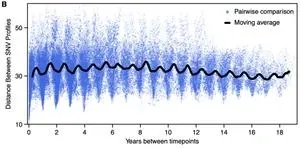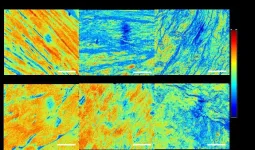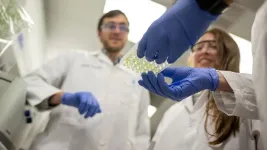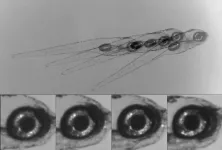(Press-News.org) Like Bill Murray in the movie “Groundhog Day,” bacteria species in a Wisconsin lake are in a kind of endless loop that they can’t seem to shake. Except in this case, it’s more like Groundhog Year.
According to a new study in Nature Microbiology, researchers found that through the course of a year, most individual species of bacteria in Lake Mendota rapidly evolved, apparently in response to dramatically changing seasons. Gene variants would rise and fall over generations, yet hundreds of separate species would return, almost fully, to near copies of what they had been genetically prior to a thousand or so generations of evolutionary pressures. (Individual microbes have lifespans of only a few days — not whole seasons — so the scientists’ work involved comparing bacterial genomes to examine changes in species over time.) This same seasonal change played out year after year, as if evolution was a movie run back to the beginning each time and played over again, seemingly getting nowhere.
“I was surprised that such a large portion of the bacterial community was undergoing this type of change,” said Robin Rohwer, a postdoctoral researcher at The University of Texas at Austin in the lab of co-author Brett Baker. “I was hoping to observe just a couple of cool examples, but there were literally hundreds.”
Rohwer led the research, first as a doctoral student working with Trina McMahon at the University of Wisconsin-Madison and then at UT.
Lake Mendota changes greatly from season to season — during the winter, it’s covered in ice, and during the summer, it’s covered in algae. Within the same bacterial species, strains that are better adapted to one set of environmental conditions will outcompete other strains for a season, while other strains will get their chance to shine during different seasons.
The team used a one-of-a-kind archive of 471 water samples collected over 20 years from Lake Mendota by McMahon, Rohwer and other UW-Madison researchers as part of National Science Foundation-funded long-term monitoring projects. For each water sample, they assembled a metagenome, all of the genetic sequences from fragments of DNA left behind by bacteria and other organisms. This resulted in the longest metagenome time series ever collected from a natural system.
“This study is a total game changer in our understanding of how microbial communities change over time,” Baker said. “This is just the beginning of what these data will tell us about microbial ecology and evolution in nature.”
This archive also revealed longer-lasting genetic changes.
In 2012, the lake experienced unusual conditions: The ice cover melted early, the summer was hotter and drier than usual, the flow of water from a river that feeds into the lake dwindled, and algae, which are an important source of organic nitrogen for bacteria, were more scarce than usual. As Rohwer and the team discovered, many of the bacteria in the lake that year experienced a major shift in genes related to nitrogen metabolism, possibly due to the scarcity of algae.
“I thought, out of hundreds of bacteria, I might find one or two with a long-term shift,” Rohwer said. “But instead, 1 in 5 had big sequence changes that played out over years. We were only able to dig deep into one species, but some of those other species probably also had major gene changes.”
Climate scientists predict more extreme weather events — like the hot, dry summer experienced at Lake Mendota in 2012 — for the midwestern U.S. during the coming years.
“Climate change is slowly shifting the seasons and average temperatures, but also causing more abrupt, extreme weather events,” Rohwer said. “We don’t know exactly how microbes will respond to climate change, but our study suggests they will evolve in response to both these gradual and abrupt changes.”
Unlike another famous bacterial evolution experiment at UT, the Long-Term Evolution Experiment, Rohwer and Baker’s study involved bacterial evolution under complex and constantly changing conditions in nature. The researchers used the supercomputing resources at the Texas Advanced Computing Center (TACC) to reconstruct bacterial genomes from short sequences of DNA in the water samples. The same work that took a couple of months to complete at TACC would have taken 34 years with a laptop computer, Rohwer estimated, involving over 30,000 genomes from about 2,800 different species.
“Imagine each species’ genome is a book, and each little DNA fragment is a sentence,” Rohwer said. “Each sample has hundreds of books, all cut up into these sentences. To reassemble each book, you have to figure out which book each sentence came from and put them back together in order.”
Other co-authors of the new study are Mark Kirkpatrick at UT; Sarahi Garcia of Carl von Ossietzky University of Oldenburg (Germany) and Stockholm University; and Matthew Kellom of the U.S. Department of Energy’s Joint Genome Institute.
This is one of two related papers publishing today in the journal; the companion paper focuses on the ecology and evolution of viruses from the same lake samples.
Support for this research was provided in part by the U.S. National Science Foundation, U.S. National Institutes of Health, the Office of Science of the U.S. Department of Energy, U.S. Department of Agriculture, the Simons Foundation and the E. Michael and Winona Foster-WARF Wisconsin Idea Graduate Fellowship in Microbiology.
END
Some bacteria evolve like clockwork with the seasons
The longest natural metagenome time series ever collected, with microbes, reveals a startling evolutionary pattern on repeat.
2025-01-03
ELSE PRESS RELEASES FROM THIS DATE:
New imaging technique offers insight into Achilles tendon injury recovery
2025-01-03
Achilles tendon injuries are common but challenging to monitor during recovery due to the limitations of current imaging techniques. Researchers, led by Associate Professor Zeng Nan from the International Graduate School at Shenzhen, Tsinghua University, have applied Mueller matrix polarimetry, a non-invasive imaging method, to more accurately observe and evaluate the healing of Achilles tendon injuries. This technique offers unique insights by capturing the subtle changes in tendon tissue without needing labels or dyes, allowing for more natural tissue characterization.
The study used Mueller ...
Bereavement science researcher provides insights on parasocial grief
2025-01-03
MIAMI, FLORIDA (Jan. 2, 2025) – Many people are surprised by the intensity of their response when a well-known person dies, and their feelings of sadness may last longer than they expect. In fact, that sadness and grief can be intense, and preliminary research suggests that grief after the death of a public figure looks very similar to grief over our personal relationships and can have comparable levels of intensity.
Wendy Lichtenthal, Ph.D., a bereavement science researcher, is available to discuss “parasocial grief” – that which occurs when a celebrity, political ...
New research aims to improve bridge construction in Texas
2025-01-02
A groundbreaking method for bridge construction is set to enhance performance, reduce construction time, and cut costs for future bridges across Texas.
Dr. Kinsey Skillen, assistant professor in the Civil and Environmental Engineering Department at Texas A&M University, was named Principal Investigator (PI) of the Texas Department of Transportation (TxDOT) research project titled “Develop/Refine Design Provisions for Headed and Hooked Reinforcement.”
The 42-month project, which received nearly $1 million in funding, is a joint effort between the Texas Transportation Institute and the University of Texas at San Antonio (UTSA) exploring more efficient methods ...
These bacteria perform a trick that could keep plants healthy
2025-01-02
To stay healthy, plants balance the energy they put into growing with the amount they use to defend against harmful bacteria. The mechanisms behind this equilibrium have largely remained mysterious.
Now, engineers at Princeton have found an answer in an unexpected place: the harmless, or sometimes beneficial, bacteria that cluster around plants’ roots.
In an article published Dec. 24 in the journal Cell Reports, researchers showed that some types of soil bacteria can influence a plant’s ...
Expanding the agenda for more just genomics
2025-01-02
Genomics is being integrated into biomedical research, medicine, and public health at a rapid pace, but the capacities necessary to ensure the fair, global distribution of benefits are lagging. A new special report outlines opportunities to enhance justice in genomics, toward a world in which genomic medicine promotes health equity, protects privacy, and respects the rights and values of individuals and communities.
The report, “Envisioning a More Just Genomics,” is a collaboration between ...
Detecting disease with only a single molecule
2025-01-02
UC Riverside scientists have developed a nanopore-based tool that could help diagnose illnesses much faster and with greater precision than current tests allow, by capturing signals from individual molecules.
Since the molecules scientists want to detect -- generally certain DNA or protein molecules -- are roughly one-billionth of a meter wide, the electrical signals they produce are very small and require specialized detection instruments.
“Right now, you need millions of molecules to detect ...
Robert McKeown recognized for a half century of distinguished service
2025-01-02
NEWPORT NEWS, VA – For nearly half a century, Robert D. “Bob” McKeown has probed nuclear particles and educated rising generations of physicists. Now, the former deputy director for science at the U.S. Department of Energy’s Thomas Jefferson National Accelerator Facility is being honored for his outstanding career contributions with the 2024 American Physical Society’s Division of Nuclear Physics (DNP) Distinguished Service Award.
McKeown is recognized for his work in experimental physics and his extensive leadership in the broader ...
University of Maryland awarded $7.8 million to revolutionize renewable energy for ocean monitoring devices
2025-01-02
University of Maryland researcher Stephanie Lansing received a Phase 1 $7.8M award from Defense Advanced Research Projects Agency (DARPA) to develop and test a biologically fueled energy source to power research and sensing devices throughout the world’s oceans.
There is a vast array of ocean sensing devices that provide critical information for understanding marine environments, monitoring climate change and maintaining national security. Many of these sensors are currently powered by long underwater cables or lithium-ion batteries.
Lansing is leading a large, collaborative effort that will overcome the need for batteries and ship-based or shore-based ...
Update: T cells may offer some protection in an H5N1 ‘spillover’ scenario
2025-01-02
Update: This LJI study was previously shared on bioRxiv in September 2024. Since then, health officials have reported a rise in H5N1 “bird flu” infections in humans, including the first severe H5N1 human case requiring hospitalization. Officials have also reported increased cases in feline species, including an outbreak among big cats at a wildlife sanctuary. In California, the recent spread of H5N1 to dairy herds in Southern California prompted Gov. Gavin Newsom to declare a “State of Emergency” on Dec. 18, 2024.
LA JOLLA, CA—New research led by scientists at La Jolla Institute for Immunology (LJI) ...
Newborn brain circuit stabilizes gaze
2025-01-02
An ancient brain circuit, which enables the eyes to reflexively rotate up as the body tilts down, tunes itself early in life as an animal develops, a new study finds.
Led by researchers at NYU Grossman School of Medicine, the study revolves around how vertebrates, which includes humans and animals spanning evolution from primitive fish to mammals, stabilize their gaze as they move. To do so they use a brain circuit that turns any shifts in orientation sensed by the balance (vestibular) system in their ears into an instant counter-movement by their eyes.
Called ...
LAST 30 PRESS RELEASES:
House sparrows in northern Norway can help us save other endangered animals
Crohn's & Colitis Foundation survey reveals more than 1/3 of young adults with IBD face step therapy insurance barriers
Tethered UAV autonomous knotting on environmental structures for transport
Decentralized social media platforms unlock authentic consumer feedback
American Pediatric Society announces Vanderbilt University School of Medicine as host institution for APS Howland Visiting Professor Program
Scientists discover first method to safely back up quantum information
A role for orange pigments in birds and human redheads
Pathways to net-zero greenhouse gas emissions for Southeast Asia
A JBNU–KIMS collaborative study on a cost-effective alloy matches superalloys for power plants and energy infrastructure
New study overturns long-held model of how plants coordinate immune responses.
New AI model predicts disease risk while you sleep
Scientists discover molecular ‘reshuffle’ and crack an 80-year-old conundrum
How stressors during pregnancy impact the developing fetal brain
Electrons lag behind the nucleus
From fungi to brain cells: one scientist's winding path reveals how epigenomics shapes neural destiny
Schizophrenia and osteoporosis share 195 genetic loci, highlighting unexpected biological bridges between brain and bone
Schizophrenia-linked genetic variant renders key brain receptor completely unresponsive to both natural and therapeutic compounds
Innovative review reveals overlooked complexity in cellular energy sensor's dual roles in Alzheimer's disease
Autism research reframed: Why heterogeneity is the data, not the noise
Brazil's genetic treasure trove: supercentenarians reveal secrets of extreme human longevity
The (metabolic) cost of life
CFRI special issue call for papers: New Frontiers in Sustainable Finance
HKU Engineering scholar demonstrates the smallest all-printed infrared photodetectors to date
Precision empowerment for brain "eavesdropping": CAS team develops triple-electrode integrated functional electrode for simultaneous monitoring of neural signals and chemical transmitters during sleep
Single-capillary endothelial dysfunction resolved by optoacoustic mesoscopy
HKU three research projects named among ‘Top 10 Innovation & Technology News in Hong Kong 2025’ showcasing excellence in research and technology transfer
NLRSeek: A reannotation-based pipeline for mining missing NLR genes in sequenced genomes
A strand and whole genome duplication–aware collinear gene identification tool
Light storage in light cages: A revolutionary approach to on-chip quantum memories
Point spread function decoupling in computational fluorescence microscopy
[Press-News.org] Some bacteria evolve like clockwork with the seasonsThe longest natural metagenome time series ever collected, with microbes, reveals a startling evolutionary pattern on repeat.








